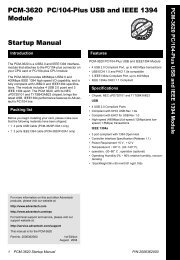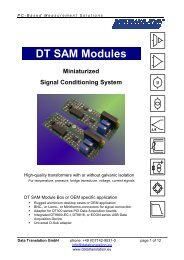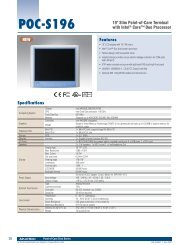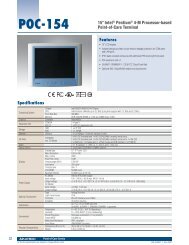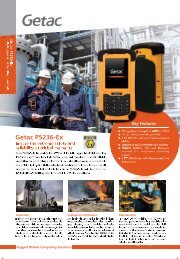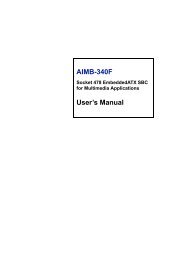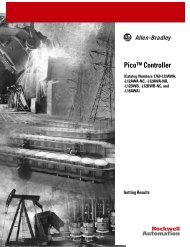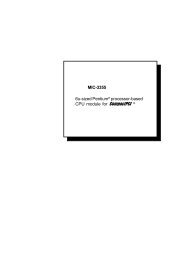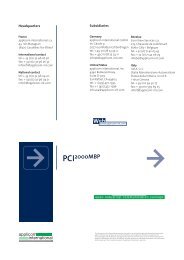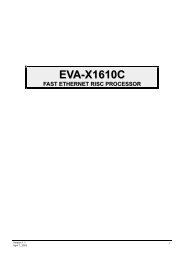- Page 1 and 2:
Motion Modules in Logix5000 Control
- Page 3 and 4:
Introduction Updated Information Su
- Page 5 and 6:
Table of Contents Preface Introduct
- Page 7 and 8:
Table of Contents 3 Appendix C Axis
- Page 9 and 10:
Introduction Description of The Mod
- Page 11 and 12:
Introduction Start Chapter 1 Use th
- Page 13 and 14:
Add the Motion Modules 1. 2. 3. 4.
- Page 15 and 16:
Set Up Each SERCOS Interface Module
- Page 17 and 18:
Action Details 2. Add the motion gr
- Page 19 and 20:
Set Up Each Axis Action Details 1.
- Page 21 and 22:
Action Details 7. Apply your change
- Page 23 and 24:
Tune Each Axis 5. ATTENTION ! 6. Ty
- Page 25 and 26:
Program Motion Control See: • Log
- Page 27 and 28:
What’s Next? Start 1-17 Use these
- Page 29 and 30:
Introduction Chapter 2 Test an Axis
- Page 31 and 32:
Access the Motion Direct Commands f
- Page 33 and 34:
Test an Axis with Motion Direct Com
- Page 35 and 36:
Motion Group Shutdown Button Test a
- Page 37 and 38:
Motion Direct Command Verification
- Page 39 and 40:
What If The Software Goes Offline o
- Page 41 and 42:
Introduction Guidelines for Homing
- Page 43 and 44:
Sequence Description Active home to
- Page 45 and 46:
Sequence Description Active home to
- Page 47 and 48:
Introduction Handle Faults The cont
- Page 49 and 50:
Choose the Fault Actions for an Axi
- Page 51 and 52:
Introduction Chapter 5 Create and C
- Page 53 and 54:
New Tag Parameters Create and Confi
- Page 55 and 56:
Create and Configure a Coordinate S
- Page 57 and 58:
Create and Configure a Coordinate S
- Page 59 and 60:
Axis Name Create and Configure a Co
- Page 61 and 62:
Axis Grid Create and Configure a Co
- Page 63 and 64:
Maximum Acceleration Create and Con
- Page 65 and 66:
Create and Configure a Coordinate S
- Page 67 and 68:
Coordinate System Attributes Exampl
- Page 69 and 70:
Attribute Data Type Access Descript
- Page 71 and 72:
Attribute Data Type Access Descript
- Page 73 and 74:
Attribute Data Type Access Descript
- Page 75 and 76:
Introduction Inhibit an Axis When t
- Page 77 and 78:
To inhibit all of the axes of a mot
- Page 79 and 80:
Example: Inhibit an Axis 1. Make su
- Page 81 and 82:
Introduction 1756-M02AE Module OK L
- Page 83 and 84:
1756-M02AS Module OK Light 2 AXIS S
- Page 85 and 86:
DRIVE Light State Description Recom
- Page 87 and 88:
FDBK Light State Description Recomm
- Page 89 and 90:
SERCOS interface Module 1756-M03SE,
- Page 91 and 92:
Introduction Why does my axis accel
- Page 93 and 94:
Why does my axis overshoot its targ
- Page 95 and 96:
Corrective action Use a Motion Axis
- Page 97 and 98:
Start while decelerating Troublesho
- Page 99 and 100:
Troubleshoot Axis Motion 8-9 Cause
- Page 101 and 102:
Introduction Wiring Diagrams Use th
- Page 103 and 104:
Ultra 100 Series Drive Ultra 200 Se
- Page 105 and 106:
Ultra3000 Drive Ultra3000 to 1756-M
- Page 107 and 108:
1394 Servo Drive (in Torque Mode on
- Page 109 and 110:
1756-M02AS Module +OUT-0 -OUT-0 +EN
- Page 111 and 112:
1756-HYD02 Module +OUT-0 -OUT-0 +EN
- Page 113 and 114:
Temposonic GH Feedback Device +Inte
- Page 115 and 116:
Home Limit Switch Input OK Contacts
- Page 117 and 118:
Introduction Interpreting the Diagr
- Page 119 and 120:
Torque Offset Velocity Offset Posit
- Page 121 and 122:
Torque Offset Velocity Offset Posit
- Page 123 and 124:
Torque Offset Velocity Offset Posit
- Page 125 and 126:
Velocity Offset Velocity Command (C
- Page 127 and 128:
Torque Servo Servo Loop Block Diagr
- Page 129 and 130:
Introduction General Tab - AXIS_SER
- Page 131 and 132:
Axis Properties C-3 • Feedback On
- Page 133 and 134:
Axis Properties C-5 chosen the axis
- Page 135 and 136:
General Tab - AXIS_GENERIC The AXIS
- Page 137 and 138:
Axis Properties C-9 specified in th
- Page 139 and 140:
Units Tab Axis Properties C-11 The
- Page 141 and 142:
Axis Properties C-13 Loop Configura
- Page 143 and 144:
Linear Displacement Transducer (LDT
- Page 145 and 146:
Axis Properties C-17 When the servo
- Page 147 and 148:
Drive/Motor Tab - (AXIS_SERVO_DRIVE
- Page 149 and 150:
• Position Servo • Aux Position
- Page 151 and 152:
Axis Properties C-23 Filters There
- Page 153 and 154:
Axis Properties C-25 Calculate Para
- Page 155 and 156:
Aux Feedback Tab - AXIS_SERVO_DRIVE
- Page 157 and 158:
Conversion Tab Axis Properties C-29
- Page 159 and 160:
Mode Select the homing mode: Axis P
- Page 161 and 162:
Axis Properties C-33 If the Positio
- Page 163 and 164:
Homing Tab - AXIS_VIRTUAL Axis Prop
- Page 165 and 166:
Axis Properties C-37 positive direc
- Page 167 and 168:
• Negative Axis Properties C-39 N
- Page 169 and 170:
Axis Properties C-41 Note: In some
- Page 171 and 172:
Dynamics Tab Axis Properties C-43 S
- Page 173 and 174:
Axis Properties C-45 clicking on th
- Page 175 and 176:
Axis Properties C-47 for an axis of
- Page 177 and 178:
Axis Properties C-49 be computed ba
- Page 179 and 180: Gains Tab - AXIS_SERVO_DRIVE Axis P
- Page 181 and 182: Axis Properties C-53 • edit on th
- Page 183 and 184: Axis Properties C-55 must be stress
- Page 185 and 186: Axis Properties C-57 Manual Adjust
- Page 187 and 188: Axis Properties C-59 The parameters
- Page 189 and 190: Axis Properties C-61 Enable Low-pas
- Page 191 and 192: Axis Properties C-63 for an axis of
- Page 193 and 194: Axis Properties C-65 resonance beha
- Page 195 and 196: Axis Properties C-67 for an axis of
- Page 197 and 198: Axis Properties C-69 For example, s
- Page 199 and 200: Axis Properties C-71 • edit in th
- Page 201 and 202: Axis Properties C-73 Tolerance, Pea
- Page 203 and 204: Table 3.F Attribute Description Axi
- Page 205 and 206: Friction/Deadband Compensation Axis
- Page 207 and 208: Offset Tab - AXIS_SERVO_DRIVE Axis
- Page 209 and 210: Axis Properties C-81 value, for the
- Page 211 and 212: Fault Actions Tab - AXIS_SERVO Axis
- Page 213 and 214: Axis Properties C-85 • Disable Dr
- Page 215 and 216: for an axis of the type AXIS_SERVO_
- Page 217 and 218: Axis Properties C-89 Feedback Speci
- Page 219 and 220: save your changes, all pending chan
- Page 221 and 222: Introduction How to Access Attribut
- Page 223 and 224: Axis Attributes D-3 Attribute Axis
- Page 225 and 226: Axis Attributes D-5 Attribute Axis
- Page 227 and 228: Axis Attributes D-7 Acceleration AX
- Page 229: Attribute Axis Type Data Type Acces
- Page 233 and 234: Axis Attributes D-13 Attribute Axis
- Page 235 and 236: Attribute Axis Type Data Type Acces
- Page 237 and 238: Axis Attributes D-17 Attribute Axis
- Page 239 and 240: Axis Attributes D-19 Attribute Axis
- Page 241 and 242: Axis Attributes D-21 Attribute Axis
- Page 243 and 244: Axis Attributes D-23 Attribute Axis
- Page 245 and 246: Axis Attributes D-25 Attribute Axis
- Page 247 and 248: Axis Attributes D-27 Conversion AXI
- Page 249 and 250: Attribute Axis Type Data Type Acces
- Page 251 and 252: Attribute Axis Type Data Type Acces
- Page 253 and 254: Attribute Axis Type Data Type Acces
- Page 255 and 256: Attribute Axis Type Data Type Acces
- Page 257 and 258: Attribute Axis Type Data Type Acces
- Page 259 and 260: Attribute Axis Type Data Type Acces
- Page 261 and 262: Attribute Axis Type Data Type Acces
- Page 263 and 264: Attribute Axis Type Data Type Acces
- Page 265 and 266: Axis Attributes D-45 Attribute Axis
- Page 267 and 268: Axis Attributes D-47 Attribute Axis
- Page 269 and 270: Axis Attributes D-49 Attribute Axis
- Page 271 and 272: Axis Attributes D-51 Attribute Axis
- Page 273 and 274: Axis Attributes D-53 Attribute Axis
- Page 275 and 276: Axis Attributes D-55 Master Input A
- Page 277 and 278: Axis Attributes D-57 Maximum AXIS_G
- Page 279 and 280: Attribute Axis Type Data Type Acces
- Page 281 and 282:
Attribute Axis Type Data Type Acces
- Page 283 and 284:
Attribute Axis Type Data Type Acces
- Page 285 and 286:
Attribute Axis Type Data Type Acces
- Page 287 and 288:
Attribute Axis Type Data Type Acces
- Page 289 and 290:
Axis Attributes D-69 Attribute Axis
- Page 291 and 292:
Attribute Axis Type Data Type Acces
- Page 293 and 294:
Axis Attributes D-73 Attribute Axis
- Page 295 and 296:
Axis Attributes D-75 Attribute Axis
- Page 297 and 298:
Axis Attributes D-77 Attribute Axis
- Page 299 and 300:
Axis Attributes D-79 Attribute Axis
- Page 301 and 302:
Axis Attributes D-81 Attribute Axis
- Page 303 and 304:
Axis Attributes D-83 Attribute Axis
- Page 305 and 306:
Attribute Axis Type Data Type Acces
- Page 307 and 308:
Axis Attributes D-87 Attribute Axis
- Page 309 and 310:
Axis Attributes D-89 Attribute Axis
- Page 311 and 312:
Attribute Axis Type Data Type Acces
- Page 313 and 314:
Axis Attributes D-93 Attribute Axis
- Page 315 and 316:
Axis Attributes D-95 Torque Scaling
- Page 317 and 318:
Axis Attributes D-97 Tune Inertia A
- Page 319 and 320:
Attribute Axis Type Data Type Acces
- Page 321 and 322:
Axis Attributes D-101 Attribute Axi
- Page 323 and 324:
Axis Attributes D-103 Attribute Axi
- Page 325 and 326:
Attribute Axis Type Data Type Acces
- Page 327 and 328:
Attribute Axis Type Data Type Acces
- Page 329 and 330:
Attribute Axis Type Data Type Acces
- Page 331 and 332:
Introduction AXIS_CONSUMED Axis Dat
- Page 333 and 334:
Member Data Type Style Axis Data Ty
- Page 335 and 336:
Member Data Type Style Axis Data Ty
- Page 337 and 338:
Member Data Type Style Axis Data Ty
- Page 339 and 340:
AXIS_SERVO_DRIVE Axis Data Types E-
- Page 341 and 342:
Member Data Type Style Axis Data Ty
- Page 343 and 344:
AXIS_VIRTUAL Axis Data Types E-13 M
- Page 345 and 346:
Numerics 1394C Drive module inhibit
- Page 347 and 348:
Reversal Offset C-78 Stabilization
- Page 349 and 350:
M Motion Apply Axis Tuning 2-5 Moti
- Page 351 and 352:
Attribute Error Code D-8 Attribute
- Page 353 and 354:
Friction Compensation Window D-49 M
- Page 355 and 356:
Specifications P-1 1756-HYD02 Motio
- Page 357 and 358:
Notes: Index 13 Publication LOGIX-U
- Page 359 and 360:
Pub. Title/Type Motion Modules in L
- Page 361 and 362:
Allen-Bradley, CompactLogix, Contro
- Page 363:
Motion Modules in Logix5000 Control




